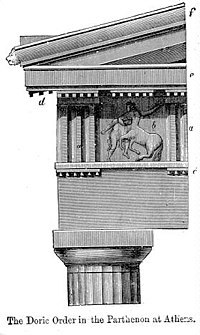Doric order

The Doric order was one of the three orders or organizational systems of Ancient Greek or classical architecture; the other two orders were the Ionic and the Corinthian. The Greek Doric order was the earliest of these, known from the 7th century BC and reaching its mature form in the 5th century BC.
In their original Greek version, Doric columns stood directly on the flat pavement (the stylobate) of a temple without a base; their vertical shafts were fluted with parallel concave grooves; and they were topped by a smooth capital that flared from the column to meet a square abacus at the intersection with the horizontal beam ("entablature") that they carried. A pronounced feature of both Greek and Roman versions of the Doric order are the triglyphs and metopes. The triglyphs are decoratively grooved and represent the original wooden end-beams, which rest on the plain frieze that occupies the lower half of the entablature. Under each triglyph are peglike guttae that appear as if they were hammered in from below to stabilize the post-and-beam ("trabeated") construction. A triglyph is centered above every column, with another (or sometimes two) between columns, though the Greeks felt that the corner triglyph should form the corner of the entablature, creating an inharmonious mismatch with the supporting column. The spaces between the triglyphs are the metopes. They may be left plain, or they may be carved in low relief. Because the metopes are somewhat flexible in their proportions, the modular space between columns ("intercolumniation") can be adjusted by the architect. Often the last two columns were set slightly closer together, to give a subtle visual strengthening to the corners.
Early examples of the Doric order include the temples at Paestum, in southern Italy, a region called Magna Graecia, which was settled by Greek colonists and retained a strongly Hellenic culture.
The Temple of the Delians (illustration right) is a "peripteral" Doric temple, the largest of three dedicated to Apollo on the island of Delos. It was begun in 478 BC and never completely finished. During their period of independence from Athens, the Delians reassigned the temple to the island of Poros. It is "hexastyle", with six columns across the pedimented end and thirteen along each long face. All the columns are centered under a triglyph in the frieze, except for the corner columns. The plain, unfluted shafts on the columns stand directly on the platform (the stylobate), without bases. The recessed "necking" at the top of the shafts and the wide cushionlike echinus are a slightly self-conscious archaizing features, for Delos is Apollo's ancient birthplace.

A classic statement of the Greek Doric order is the Temple of Hephaestus in Athens, built about 449 BC. See the Wikipedia entry for photographs that show its details. The contemporary Parthenon, the largest temple in classical Athens, is also in the Doric order, although the sculptural enrichment is more familiar in the Ionic order: the Greeks were never as doctrinaire in the use of the Classical vocabulary as Renaissance theorists or neoclassical architects. The detail (illustration, left), part of the basic vocabulary of trained architects from the later 18th century onwards, shows how the width of the metopes was flexible: here they bear the famous bas-relief sculptures of the battle of Lapiths and Centaurs.

In the Roman Doric version (illustration, right), the height of the entablature has been reduced. The endmost triglyph is centered over the column rather than occupying the corner of the architrave. The columns are slightly less robust in their proportions. Below their caps, an astragal molding encircles the column like a ring. Crown moldings soften transitions between frieze and cornice and emphasize the upper edge of the abacus. Roman Doric columns also have moldings at their bases and stand on low square pads or are even raised on plinths. In the Roman Doric mode, columns are not invariably fluted.
